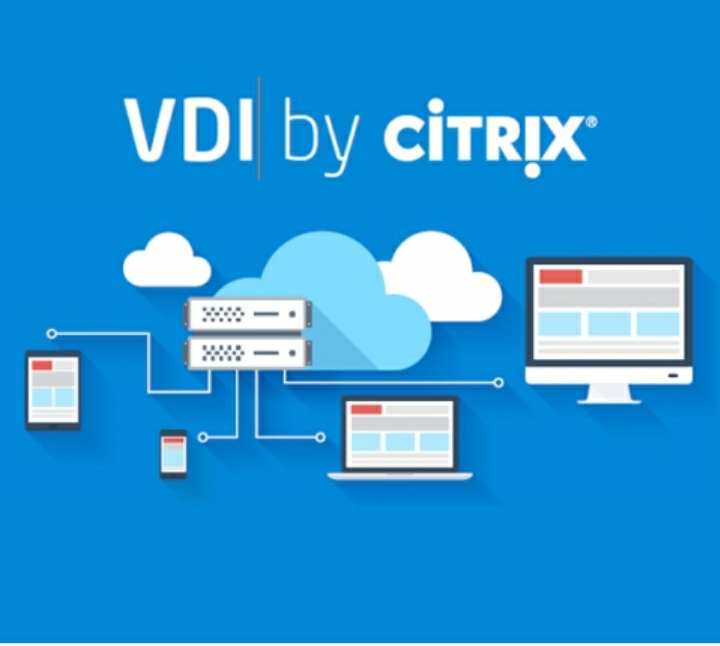Citrix VDI
An American company that produces programs useful for safe access to applications and any content on servers. Among these programs are services and programs for web servers, programming, and design. The company was established in 1989 and is known as “Citrix Systems”. There are several subsidiaries around the world working to provide products for Windows Mac OS and Linux.
Citrix VDI XenDesktop
is a Virtual Desktop Infrastructure product that allows users to remotely access and operate Microsoft Windows desktops in a data center or public or private cloud via devices elsewhere. Citrix Receiver enables users to access virtual Windows applications and desktops and virtual applications are managed and delivered through XenApp
How does Citrix XenDesktop work?
The cloud service aims to enable employees to work from anywhere and this reduces the costs of the technology department due to the central administration. In addition, it adds to data security because the data is saved in a central data center or cloud infrastructure, and it is not stored on end-user devices. The product is developed for use by medium and large enterprise customers. Applications and desktops are managed through a communication medium known as Desktop Delivery Controller (DDC). DDC supports several hypervisors, including XenServer, VMware vSphere, Microsoft Hyper-V, and Nutanix Acropolis to create virtual machines to run applications and virtual desktops. It is compatible with several types of delivery methods and architectures, including desktop computers, servers, data centers, and private, public, or hybrid clouds. XenDesktop is equipped with Citrix XenServer Hypervisor and Image Management Support Services. Naturally, Citrix XenApp enables virtual applications to be delivered to virtual desktops.
Main Features of Citrix VDI XenDesktop
XenDesktop publishes Citrix HDX, a suite of technologies that includes Remote Independent Computing Architecture (ICA) protocol, data compression, and multimedia forwarding, providing users with connections to desktop workloads. Virtual desktops are connected through the Citrix Receiver client Available for many operating systems, including Windows, macOS, iOS, Android, and Linux. Web browsers or thin clients can also be used to connect to virtual desktops.
1. Centralized Management:
One of the primary advantages of XenDesktop is centralized management. IT administrators can create, provision, and manage virtual desktops and applications from a single, unified console. This streamlines management tasks, reduces complexity and enhances overall efficiency.
2. High-Performance User Experience:
Citrix is renowned for its High-Definition User Experience (HDX) technology. XenDesktop leverages HDX to deliver exceptional performance, ensuring that end-users can access multimedia content, graphics-intensive applications, and data-intensive workloads with ease. This leads to improved productivity and user satisfaction.
3. Secure Access:
Security is a top priority for Citrix. XenDesktop incorporates multiple layers of security features, including multi-factor authentication, encryption, and granular access controls. It ensures that data remains protected, even when accessed remotely from various devices.
4. Scalability:
XenDesktop is highly scalable, making it suitable for organizations of all sizes. Whether you’re a small business or a large enterprise, you can tailor the solution to meet your specific needs and accommodate growth.
5. Anytime, Anywhere Access:
One of the key advantages of XenDesktop is its ability to provide remote and mobile access to desktops and applications. This flexibility enables employees to work from home, on the road, or in remote locations while maintaining a consistent user experience.
6. Cost-Efficiency:
Citrix offers various licensing options for XenDesktop, allowing organizations to choose the most cost-effective plan based on their requirements. The solution’s ability to extend the lifespan of existing hardware also contributes to cost savings.
7. Support for Multiple Devices:
XenDesktop is device-agnostic, supporting a wide range of devices, including PCs, Macs, smartphones, and tablets. This ensures that users can access their virtual desktops and applications on their preferred devices.
Use Cases for Citrix VDI XenDesktop
Citrix XenDesktop serves a broad range of use cases across industries:
- Remote Workforce Enablement: In the wake of remote work becoming a standard practice, XenDesktop enables employees to access their work environments securely, ensuring business continuity.
- BYOD (Bring Your Own Device): XenDesktop supports BYOD policies, allowing employees to use their personal devices for work while maintaining security and control.
- Temporary and Contract Workers: For organizations employing temporary or contract workers, XenDesktop provides a convenient and secure way to grant access to necessary applications and resources.
- Resource-Intensive Applications: Industries that rely on resource-intensive applications, such as 3D modeling, CAD design, or healthcare imaging, benefit from XenDesktop’s ability to deliver these applications efficiently.
XenDesktop and XenApp
XenDesktop includes XenApp. They both share many advantages, but XenApp offers control and access to many users who connect to session-based applications or a virtual desktop machine on a shared server for remote virtualization infrastructure services. With XenDesktop, each client receives an instance from the desktop and does not Desktop instances are shared between users. While XenDesktop is a remote desktop rendering platform, you will also need an XenApp app rendering license in order to share both the apps and the desktop with the user.




Comments
0 comments